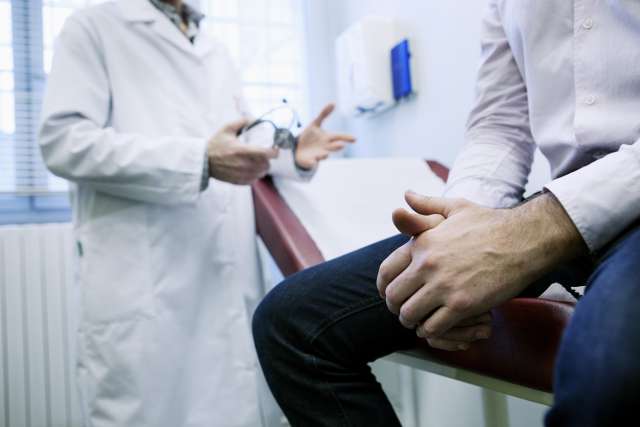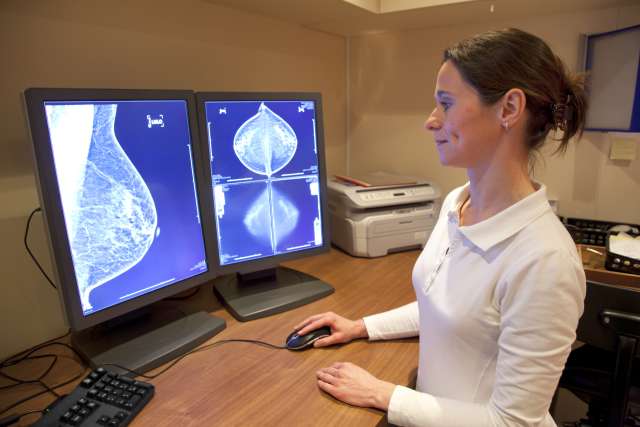May is Skin Cancer Awareness Month, and what better way to mark it than with the introduction of groundbreaking treatment for early-stage melanomas.
The new technique uses standard Mohs micrographic surgery combined with advanced intraoperative immunohistochemical staining, which enables the surgeon to pinpoint and remove the tumor at its surgical margin with nearly 100% accuracy.
Mohs surgery, originally developed in the late 1930s by a general surgeon named Frederic E. Mohs, is a specialized form of microscopically controlled surgery used to treat skin cancer. The surgeon removes the cancer and precisely maps the tumor in a 360-degree fashion.
While the patient waits, the surgeon examines the tissue under the microscope, looking for any remaining cancer cells. If any cancer cells are left, the surgeon is able to identify their precise location and go back and take a targeted strike of that area only, leaving the remaining healthy tissue behind. This process is repeated until the tumor is completely removed, while preserving as much healthy tissue as possible.
With this technique, cure rates greater than 99% can be achieved for most common skin cancers. Mohs surgery is now considered the gold standard for treatment of the most common forms of skin cancer.
Despite its success rate, Mohs micrographic surgery was not frequently used, until recently, for the treatment of melanoma, given the difficulty interpreting melanomas under the microscope using standard tissue staining techniques. However, with the new highly specialized immunostaining techniques using antibodies that target melanoma cells specifically, the surgeon is now able to precisely visualize where the tumor begins and ends, eliminating the “guess work” and the need to “take big chunks,” says Teo Soleymani, MD, a health sciences clinical instructor of dermatologic surgery at UCLA Health.

UCLA Health is the first health care system in Southern California to employ this technique, which has a published success rate that is 20 to 100 times better than traditional surgery in treatment of early melanomas, says Dr. Soleymani. “With regards to the surgical management of early melanomas, it’s the single best thing that’s happened,” he says.
Results from several landmark studies comprising more than 6,000 patients over the past 10 years show a tumor cure rate of 99.5% to 99.8%, he says.
Currently, this treatment is available only at a handful of health care institutions across the nation, including the Zitelli and Brodland Skin Cancer Center in Pittsburgh, Stanford University Medical Center and the University of Pennsylvania. “It’s nice to add UCLA’s name to that group of premier institutions,” Dr. Soleymani says.
Dr. Soleymani calls this treatment a game-changer for older adults, who grew up in an era when sun protection wasn’t stressed. It is designed to treat early-stage melanomas of the head, neck, hands, feet and genitalia and those that arise from chronically sun-damaged skin.
He notes that melanomas in those areas are particularly difficult to treat because of the difficulty in obtaining clear surgical margins — the noncancerous, healthy tissue surrounding the melanoma — with standard techniques. Dr. Soleymani gives the example of a melanoma on the rim of the nose, for which surgeons are often unable take a standard margin or a large piece of healthy tissue around the tumor, which would result in significant cosmetic and functional disfigurement.
More importantly, much of the extent of the melanoma is beyond what a surgeon’s eyes can see, he says.
“With this new technique, we’re able to remove the tumor and process it in a way where we can look at 100% of the margin, but also use these newly advanced antibody stains to stain for the tumor right at the time of surgery,” Dr. Soleymani says. “If the tumor has roots going deep or to the side, we can see that with these stains.”
Dr. Soleymani first performed this new procedure at UCLA Health in late April and has treated about a half-dozen cases to date, including melanomas on the head, neck, foot, scalp and eyelid. The surgery is done with the patient fully awake, and reconstruction is performed the same day.
He notes the greatest need for advanced intraoperative immunohistochemistry in the sunbelt states, where the number of melanoma cases is skyrocketing. “Levels of breast cancer and lung cancer have plateaued, but every year melanoma increases. So, it’s nice to have this treatment option for our aging population.”
Dr. Soleymani brought this cutting-edge treatment to UCLA Health after completing an advanced fellowship in Mohs Micrographic Surgery, Cutaneous Oncology, and Facial Plastic and Reconstructive Surgery at the Zitelli and Brodland Skin Cancer Center in Pittsburgh, where they performed more than 6,000 procedures including 1,100 melanomas in 2020.
His fellowship was directed by John Zitelli, M.D., and David Brodland, M.D, widely considered to be among the pre-eminent authorities in Mohs micrographic surgery. Dr. Zitelli is one of the few remaining active surgeons who trained directly under Dr. Mohs.
Drs. Zitelli and Brodland have dedicated their careers to perfecting Mohs surgery, Dr. Soleymani says.
“In the last five years, Mohs surgery for melanoma went from being questioned in skepticism to now being incorporated in the new guidelines for care of melanoma, and being considered first line, in some cases,” he says. “Their center is the busiest in the world (for skin cancer) and I was fortunate to do my fellowship with them.”
Learn more about the Mohs producer and other dermatologic surgery at UCLA Health.
Jennifer Karmarkar is the author of this article.



